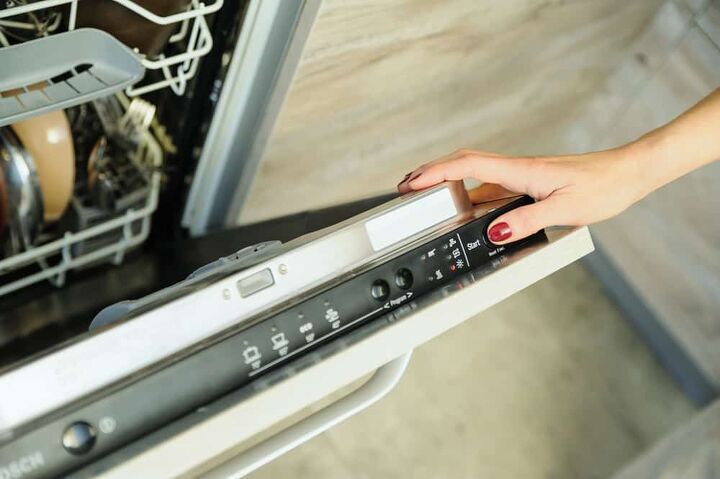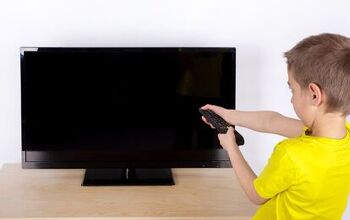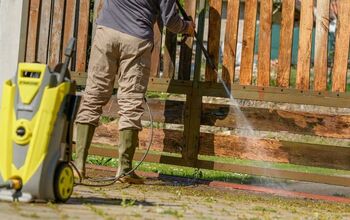Dishwasher Won't Start But Has Power? (Possible Causes & Fixes)

A dishwasher may be one of the most useful appliances in the kitchen. However, when it isn’t working, it can put a halt to a functioning kitchen. Whether a renter or homeowner, the disdain for plumbing issues is typically the same.
If your dishwasher won’t start but has power, you will have to troubleshoot it to determine the malfunction. There are several things that can cause this issue. The most common reasons are the door latch and door latch switches.
Do You Need Appliance Repair Services?
Get free, zero-commitment quotes from pro contractors near you.

Troubleshooting a Dishwasher
After making dinner, you clean the kitchen and load the dishwasher with dishes. When you shut the door, it won’t start. Before you call a professional, save time and money by troubleshooting your dishwasher.
Before you begin, always make sure you unplug the dishwasher and that the appliance’s power is off. This precaution prevents accidents like an electrical shock.
You will need a multimeter to troubleshoot your dishwasher safely. A multimeter measures voltage, current, and resistance. You can purchase one on Amazon for under $10.
Try these eight tips to troubleshoot your dishwasher.
Child Lock Setting
If you have a new model dishwasher, you may have a child lock setting. Check to see that the child lock setting is off. If you are unsure if you have this feature, check your owner’s manual.
Reset the Dishwasher
If your dishwasher has power, but it won’t start, you may have accidentally reset the dishwasher. This is a common issue when you accidentally press the start button more than once.
When you press the start button once, it starts the dishwasher. When you press the start button twice, it resets the dishwasher and runs a drain cycle run for 90 seconds. Let the drain cycle run completely, and then check if your dishwasher will start.
If the issue is not the reset button, you will have to dig deeper into the matter.
Door Latch or Door Switch
Some of the most common issues for a dishwasher not starting involve the door latch or door switch. The purpose of the door latch is to hold the door closed during the cycle. The door latch also prevents water from leaking.
The door latch switch supplies power to the dishwasher controls. If the door cannot close properly, the door latch won’t activate the door latch switch. The dishwasher controls will not receive power, and the dishwasher will not start.
Follow the steps below using a multimeter to inspect the door latch and door latch switches.
Step 1: Disconnect from Power Source
As mentioned before, disconnect the dishwasher from the power source before beginning.
Step 2: Remove the Inner Door Panel
Remove the door panel on the inside of the dishwasher. Once you are inside, you can access the door latch found at the top of the door. Check that the catch piece activates the door latch switches by inserting the catch piece into the assembly.
Step 3: Check for Continuity
If the door latch switches work properly mechanically, you should check for continuity. Using the multimeter on Rx1, touch the probes to the door latch switch’s terminals. This should produce a reading of zero or nearly zero.
If you receive a different reading, you will need a replacement door latch assembly.
Timer or Electric Control
If you determine that the door latch and door switch are operating correctly, look at the timer or electronic control. The first step of the cycle is to drain any standing water in the dishwasher. If you don’t hear the drain running, check out the timer and electric control.
There is a manual timer in some dishwasher models that provides power at the proper sequence in the cycle. The timer supplies power to the pump motor, water inlet valve, heater circuit, and drain pump motor. Electrical contacts located inside of the timer power a small motor.
Follow these four steps using a multimeter to check the timer or electric control.
Step 1: Locate and Remove the Timer
First, disconnect the dishwasher. You can find the timer in two places: the control panel or behind the lower kick plate. The lower kick plate is the lower flap located under the dishwasher door.
Step 2: Determine the Wires to Test
Some timers will have multiple sets of contacts and wires. To determine which wire to test, locate your owner’s manual. The owner’s manual will have a wiring diagram that will let you know which contacts to test.
Step 3: Check the Contacts and Wires for Continuity
Set the multimeter to Rx1000 and touch the contacts determined in step 2 with the probes. If the timer is properly functioning, it will fall in the range of 2000-3500 ohms of resistance.
The resistance can vary between models, so refer to your owner’s manual to determine what your reading should be. If your test results differ from the manufacturer’s recommendations, you will need a replacement timer.
Selector Switch
The selector switch on a dishwasher is the panel used to select different wash cycles. Depending on your dishwasher model, the switch may be used in the motor or fill circuit. If it isn’t working properly, it could cause a dishwasher not to start.
If the buttons on the selector switch aren’t fully pressed, that could also cause the dishwasher not to run. Before taking apart the selector switch, make sure that you press the buttons properly. If it isn’t a button issue, then follow the steps below.
Follow these steps to test a dishwasher selector switch with a multimeter.
Step 1: Locate the Selector Switch
Disconnect the dishwasher and remove the inner door panel to locate the selector switch. It will most likely be on the control panel but refer to your owner’s manual to be sure. Once you locate the selector switch, make sure it is properly depressed. If it is, remove it to test it.
Step 2: Test the Selector Switch with a Multimeter
Set the multimeter to Rx1, touch the probes to the selector switch’s terminals, and test each button. This should produce a reading of infinity.
Next, with the probes still on the selector switch terminals, push in on the button being tested. This should change the reading on the multimeter to zero. Repeat this process to test the rest of the buttons.
If the readings do not match the above, you most likely need a replacement selector switch.
Motor Start Relay
Your dishwasher may use a start relay on the main pump motor. This supplies power to the motor start windings until the motor is running. Once the motor begins to run, a moving plunger inside operates a set of contacts.
Test to see that you are getting power to the motor start relay by following the steps below.
Step 1: Locate the Motor Start Relay
Unplug your dishwasher and remove the lower access panel of your dishwasher. Here you can locate the motor start relay, located next to the pump. Remove the motor to test.
Before testing, refer to your wiring diagram found in the owner’s manual.
Step 2: Test the Motor Start Relay
After you have located the appropriate wires, set the multimeter to Rx1. Test the coil portion of the motor for continuity. The test reading should be zero or nearly zero.
Step 3: Manually Activate the Motor
Next, you will need to activate the motor manually. Do this by turning it upside down and allowing the plunger to drop. After, touch the probes to the terminals of the motor.
This test should also produce a reading of zero or nearly zero. If the test results are different than above, you may need a new motor start relay.
Thermal Fuse
Test the thermal fuse if you are still struggling to get your dishwasher to work. The thermal fuse is a safety device that will stop the power to the control panel. If the thermal fuse isn’t working, the control board will not receive power causing the dishwasher not to start.
Test the thermal fuse by following these steps.
Step 1: Access the Control Panel
Access the control panel by removing the inner door of the dishwasher. The thermal fuse is attached to the control panel by two wires. Disconnect these wires carefully and remove the thermal fuse to test it.
Step 2: Test the Thermal Fuse
Set the multimeter to Rx1 and touch the fuse’s contacts with the probes. The test should have a reading of zero or nearly zero. If the reading is different, you will need a new thermal fuse.
Drive Motor
A drive motor is the piece that circulates the water to wash the items inside. The power to operate the drive motor is supplied through the timer, electronic control, or the start relay.
If the dishwasher won’t start after the start relay sends power to the motor, the drive motor could be broken. A loud, humming noise coming from the motor could also indicate that you need to replace it.
Test the drive motor with a multimeter before buying a replacement.
Step 1: Locate the Drive Motor
The drive motor is found in the lower access panel. After locating it, disconnect the wires attached to it and remove it to test for continuity.
Step 2: Test the Drive Motor
Test the drive motor by setting the multimeter to Rx1. Touch the probes to the motor’s terminals. If the drive motor is properly functioning, it should have a reading of zero or nearly zero.
Step 3: Test the Ground Connection
Test the ground connection by moving one of the multimeter probes to the metal housing of the motor. This test shouldn’t produce any reading. If the drive motor or ground connection tests produce a different reading, you will need to replace the drive motor.
However, if you try every step with no luck, you may have to contact a repairman. If your dishwasher is newer, it may still be under warranty. If it is not, contact a professional to diagnose the problem.
Do You Need Appliance Repair Services?
Get free, zero-commitment quotes from pro contractors near you.

Related Questions
Can you run a dishwasher every day?
Some people believe that you shouldn’t run your dishwasher unless it’s completely full. Others say that you shouldn’t run it often in order to save energy and money. However, there’s no rule on how often to run it. With newer technology, companies are now producing dishwashers that can run several times a day. These companies have also developed technology to reduce the amount of water used, thus saving money on your water bill. How often you choose to use your dishwasher is entirely up to you.
What is the average price of a dishwasher?
With so many companies now producing dishwashers, the consumer has many options. Dishwashers can range in price depending on the quality and features of it. For example, a lower-end dishwasher can cost about $380, whereas a higher-end one could cost up to $2,300. If you want a dishwasher with all the bells and whistles, prepare to pay a lot. If you want a dishwasher that just cleans your dishes, don’t be afraid to choose one on the cheaper side.

Stacy Randall is a wife, mother, and freelance writer from NOLA that has always had a love for DIY projects, home organization, and making spaces beautiful. Together with her husband, she has been spending the last several years lovingly renovating her grandparent's former home, making it their own and learning a lot about life along the way.
More by Stacy Randall



























